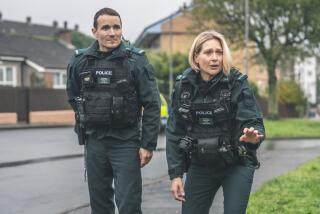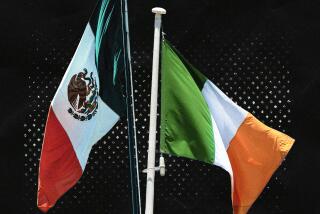IRA Order Met With Hope, Skepticism
BELFAST, Northern Ireland — In a once desolate downtown, where police searched shoppers for weapons during the deadly conflict known as “the Troubles,” dramatic changes happened long before the Irish Republican Army announced the end of its armed struggle.
As the threat of IRA bombs receded after the group’s 1997 cease-fire, new glass and steel buildings went up, and shops began staying open after dark. The IRA has been expected to give up its weapons since the landmark 1998 Good Friday agreement.
On Saturday, while streams of shoppers jostled one another and fans crowded into pubs to watch soccer on TV, some in this divided city were hopeful about Thursday’s IRA order to disarm, but others were dismissive.
“It’s nice not having so many police around now,” said Sonia McCann, 34. “I don’t ever want it to go back to the way it was, so this is good news.”
As Gareth McAleese, 33, raised money in front of City Hall for a hospital in Afghanistan, he said he hoped the IRA would keep its word this time.
“What they said was much more blunt and straightforward than statements they’ve made before,” he said. “I’d like to believe they’ll really disarm this time, but I don’t know.”
The IRA first appeared after the 1916 Easter rebellion and reemerged in 1969 as the Troubles erupted. Its campaign for the unification of British-ruled Northern Ireland and the independent Irish Republic would continue, but peacefully and democratically, it said Thursday.
On Falls Road, where Irish flags flapped, Roman Catholics were upbeat.
“It’s fantastic,” Morag McIlroy, 60, said. “We knew there was peace before, but we felt like anything could spark it all off again, and bring us right back where we were.”
Many Catholics in the staunchly republican neighborhood defended the armed campaign but also hailed its end.
“It was necessary,” said Mary Davlin, 61. “But now I think we can get a united Ireland through dialogue, eventually, in a couple of generations or so.”
Irish Prime Minister Bertie Ahern told the BBC on Friday that he did not expect Irish unification anytime soon. Catholics make up about 45% of Northern Ireland’s population. A minority of Catholics, an estimated 15% to 20%, supports remaining part of Britain, which provides huge subsidies.
When Ireland’s voters approved the Good Friday agreement, they also voted to give up their constitutional claim to Northern Ireland. The agreement stated that Irish unification would require the democratic approval of the British province and Ireland.
Several Catholics predicted that the IRA, with or without guns, would exist as long as the island remained partitioned. Some even doubted that the IRA would hand over all its weapons.
“My feeling is they’ll keep some stuff around anyway, just in case,” said Michael Cavanagh, 52.
Others spoke of how far Catholics had advanced in a province that was led solely by Protestants from its founding in 1921 until Britain imposed direct rule in 1972.
Near the headquarters of Sinn Fein, the IRA’s political ally, Geraldine Quinn said job discrimination against Catholics was blatant in the past. Employers used to determine job applicants’ religious background by asking where they had gone to school.
“If you said, ‘Saint something,’ that was it, you didn’t get the job,” she said.
Davlin pointed to educational opportunities.
“Universities are bursting at the seams with Catholics” compared with their enrollment in the 1960s, she said.
As for disarmament, many Catholics demanded that Protestant paramilitaries also lay down their weapons.
“It has to work both ways,” said Harry O’Neill, 60. “When the loyalists hand in their guns, this will really be over.”
Along Shankill Road, some Protestants agreed that the fractious pro-British unionist paramilitaries, which have been mired in a summerlong feud, should also retire.
“I would hope they’d disband, but the problem is there are so many groups that if one goes away, you can just join another,” said Andrew Steele, 21.
As expected, the Protestants, who want Northern Ireland to remain under British rule, reacted skeptically to the IRA’s declaration.
Streamers of little Union Jacks fluttered over the working-class street, where they are hung for the contentious summer marching season, when Orange Order unionists in bowler hats lead fife-and-drum bands.
“I don’t believe them, they just tell lies and never keep their promises,” Doris McCauley said. “I’d like to see it, but I don’t think I will.”
After the IRA was blamed for a $50-million bank raid and the slaying of a Belfast Catholic, Sinn Fein leader Gerry Adams prompted a prolonged debate within the IRA that led to Thursday’s announcement.
Some Protestants, however, were wary of a possible backdoor deal between Adams and British Prime Minister Tony Blair.
“I’ll never trust Adams, and I wonder what Blair promised him this time,” said Alex Graham, a 60-year-old shopkeeper.
The Shankill neighborhood, scene of some of the worst bloodshed of the Troubles and site of a 1993 IRA bombing, has improved enough that Jude Samner, an Englishman, recently bought a summer town house there.
“They were quite surprised to see me when I bought my mattress,” he said.
“Northern Ireland has great potential. I think you’ll really see a difference in another four or five years.”
More to Read
Sign up for Essential California
The most important California stories and recommendations in your inbox every morning.
You may occasionally receive promotional content from the Los Angeles Times.










